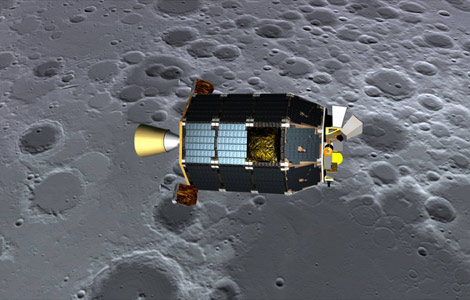NASA launches robotic explorer to moon
 |
|
NASA's Lunar Atmosphere and Dust Environment Explorer (LADEE) spacecraft is pictured orbiting near the surface of the moon, in this artist's illustration released by NASA on August 15, 2013. [Photo/Agencies] |
The US space agency NASA launched the Lunar Atmosphere and Dust Environment Explorer (LADEE) aboard a Minotaur V rocket at 11:27 pm Friday (0327 GMT Saturday) from its Wallops Flight Facility in eastern Virginia.
"There she goes. Lift off!!!" said Orbital Sciences Corp, owner of the Minotaur V rocket, via its official Twitter account. "Nominal flight so far."
Unlike the zippy three-day trip that Apollo astronauts took four decades ago, it will take about 30 days for the small car-sized spacecraft to reach the moon.
The $280 million mission will gather detailed information about the structure and composition of the thin lunar atmosphere and study how moon dust behaves above the lunar surface, according to NASA.
Some Apollo astronauts reported seeing a strange glow on the moon's horizon before sunrise during NASA's lunar landing missions in the 1960s and 1970s. Scientists think this may have been caused by electrically charged moon dust, a theory that the LADEE is expected to test.
"Sometimes we get a little bit surprised when we start talking about a lunar atmosphere, because most of us were taught in school that the moon doesn't actually have an atmosphere," astronomy website Space.com quoted Sarah Noble, NASA's LADEE program scientist, as saying. "It does, but it's very, very thin."
The Lithium battery-powered spacecraft is about 2.37 meters high, 1.85 meters wide and 1.85 meters deep, about the size of a small car, with a mass of 248.2 kilograms, or 383 kilograms when fully fueled.
Once it reaches the moon, the LADEE will begin its 40-day commissioning phase, the first 30 days of which the spacecraft will be performing activities high above the moon's surface.
These activities include testing a high-data-rate laser communication system that will enable higher rates of satellite communications similar in capability to high-speed fiber optic networks on Earth.
Next, the LADEE is expected to spend about 100 days studying the lunar environment before running out of fuel and crashing into the moon's surface.
There are no plans to target the impact points on the lunar surface, and if the spacecraft's fuel is depleted and orbital decay occurs naturally, the point of impact may not be in sight of Earth, NASA said.



























